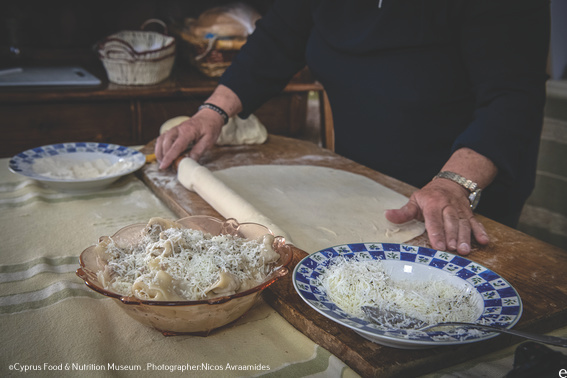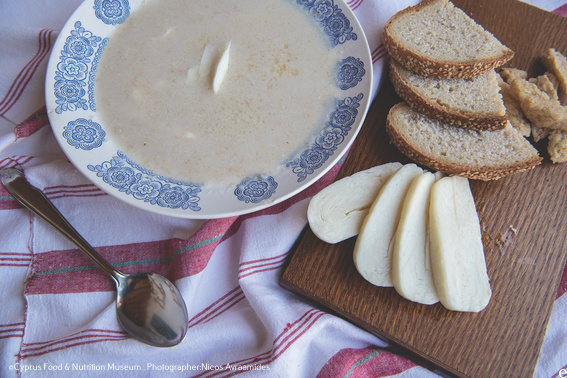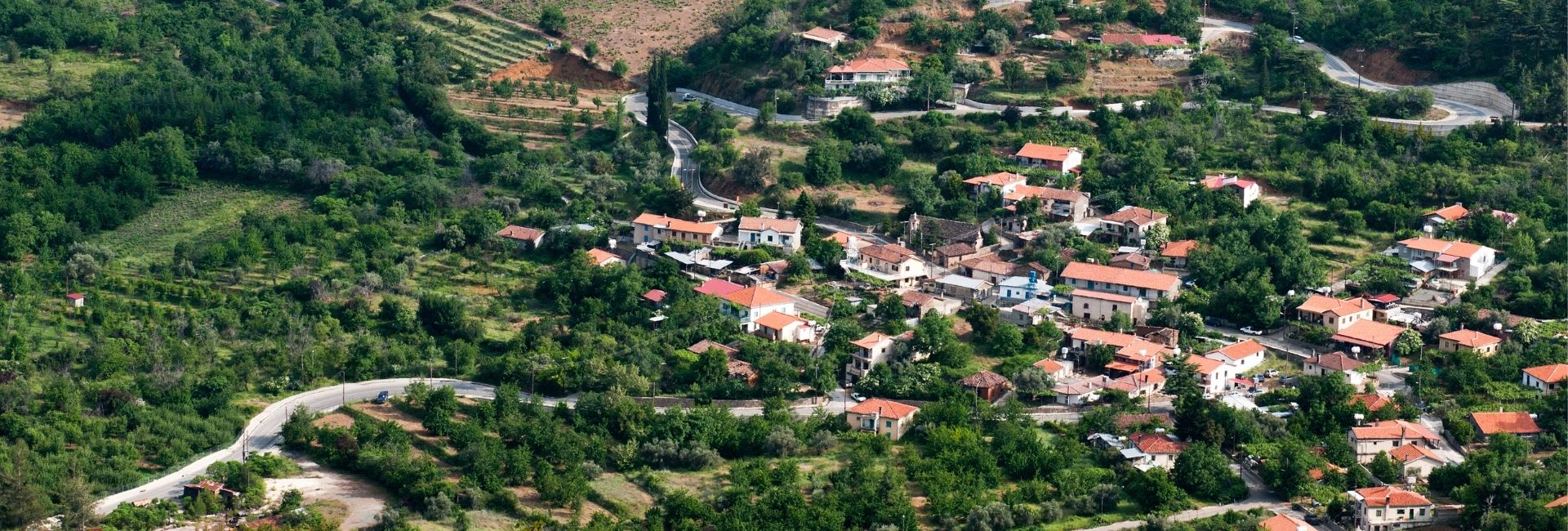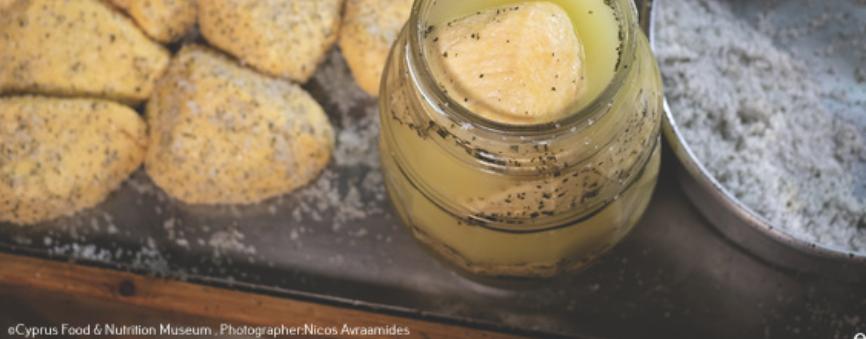Excerpt from the book «THE DAIRY CULTURE OF CYPRUS: HISTORY – TRADITION – FOLKLORE»
Production process
Although halloumi was sometimes produced by shepherds, in the traditional society of Cyprus the production of halloumi was mainly women’s work, and was an art that was passed down from stete (grandmother) to mother and from mother to daughter. Indeed, it was considered a significant qualification for a future bride to know how to κάμνει το γάλαν (literally, to work the milk), and even today, women who make good halloumi at home are known by their own names. Undoubtedly, the production of halloumi was a demanding process, and it is no accident that women helped each other to prepare it. This involved a kind of practical social solidarity, not unlike that involved in the collective planting of the new vines.
The process of tyropiasma (the transformation of milk into halloumi, cheese, or anari) usually began in June or July, when milk quantities began to decrease. Before beginning the process of making halloumi, a small quantity of milk would be reserved to use for producing anari later. The rest of the milk was strained (kouliazan) through a kouroukla (a kind of thin, sparsely woven cheesecloth, typically used to make headscarves with tails). While chanting the blessing “Έλα Χριστέ τζ̆αι Παναγία” (“bless us Jesus and Mary”) the halloumi makers would pour the milk into a ganomeni charkomaeirissa (galvanized copper pan) or ganomenon chartzin (galvanised cauldron) with a capacity of 40-50 okes, which was then placed on the niskia (hearth). They would light a fire made of branches of throumbi (wild thyme—Thymbra capitata), keeping the fire low at first, and heat the milk until it was just hot enough for a finger to be dipped in. They would then place a small piece of rennet wrapped in cloth into the pot, pressing it with their palms while they stirred it around in the milk. Next, they would remove the copper pot (charkomaeirissa or chartzin) from the fire and cover it. After a while, when the milk had thickened, the curd (drosinon or grosinon or vloungos) would float to the surface. The halloumi makers would make the sign of the cross over it and cut it cross-wise with their hands. They would then squeeze the mass, wrap it in muslin, and place it on a tyroskamnin (cheese stool). After that they would press the cheese, first with their hands and then with a weight, to extract the whey (noros), which flowed back into the pot in which the milk had been heated.
The cheese mass would then be removed from the cloth and cut into pieces. The pieces of raw halloumi were dipped in clean water and put back into the charkomaeirissa or chartzin, where they were boiled in the whey on high heat until cooked (Image 5). In some areas, such as Athienou, before the pieces of cheese were placed into the water they were tied in small pieces of cloth so that they would not lose their shape during cooking. At first the pieces of cheese remained submerged in the whey, but when cooked they rose to the surface and acquired a rubbery texture. At this point the cheese pieces would be removed from the whey, sprinkled with salt and mint, and folded in half.
The halloumi was stored in whey (noros) in clay pots known as halloumokouzes (halloumi jars), which were set in a cool place (12°-15°C) for 20-40 days until the halloumi reached the appropriate fermentation stage. In some areas, reeds, vine tendrils, or mulberry branches were placed on the surface of the whey in the shape of a cross. From time to time, the jars were opened to release the gases produced by the fermentation. The butter that gathered on the surface was removed and kept to be used for cooking. In order to protect the halloumi from cheese flies, warm olive oil or Saponaria (Saponaria Cypria, which has pharmaceutical qualities) was poured into the jars (the oil floated on the surface of the whey). For the same reason, during the cooking of the halloumi some people used to add one or two koutzatzia (unripe figs), to prevent the cheese from being infested with appiitourka (cheese worms).
Nowadays, when the fermentation process is complete, the containers are hermetically sealed and stored in refrigerators. In this way, the halloumi can be preserved in good condition for several months. Although the above process describes the general framework for making halloumi, there are some small, but important, local differences in production methods. For example, whereas certain areas used only goat or only sheep’s milk, in others the two were mixed in order to give the cheese a softer texture since halloumi made solely of goat’s milk is harder.
In the villages of the Troodos Mountains, where there are no sheep, the halloumi was made solely of goat’s milk and was known as pourota, which means “hard”. As regards the straining of the drosino (curd) from the liquid, in some areas this was done with the use of stone slabs, in others by tying the curds in cheesecloth, and in yet others by placing them in talarka, the tube-shaped filters or moulds made of sklinitzia (rushes—Juncus Maritimus). In addition, while some people collected the entire mass of curds, others removed the curd in pieces and squeezed it with their hands to remove the noros (whey). There were also differences in the cooking and final shaping of the halloumi. For example, in the Kokkinochoria the cheeses were cooked longer, until they acquired a reddish colour. In addition, whereas the halloumi cheeses were usually folded in half once they were cooked, in some villages of the Famagusta district (e.g. Frenaros and Rizokarpaso) they were left “single” (unfolded). In Paphos they were folded, but in a semi-circle.
Traditional Life
Halloumi is served raw, fried, grilled, or barbecued. Its multiple uses make it unique and a true delight throughout the year at all meals and on all occasions. Even at funerals it was, and still is, served together with bread and olives as the pariorka (consolation, meaning “coffee for consolation”).
The milking of the goats usually began 10-15 days after the birth of the kids. The first halloumi cheeses were made as a trial and eaten fresh during the week of Tyrofagou (Cheesefare week—the week before Great Lent) or used in ravkioles (ravioli stuffed with halloumi or with a mixture of halloumi and anari) and tyropoulles (small halloumi breads). Halloumi was usually eaten as prosfai (a dry meal/food eaten with bread), and was a typical part of boukkoma (breakfast), while during the harvesting and threshing season it was accompanied by warm home-made bread, cucumbers, and tomatoes. The hard halloumi that matured in the kourellous (containers a little smaller than the jars, with a handle on either side like ancient amphorae) was eaten during the winter months straight from the jar, fried with eggs, or grilled on the coals in the tsiminies (fireplace). Diced into small pieces, it was also cooked with trachanas, which gave the soup a very particular flavour.
Various items were made from halloumi, such as halloumopittes (halloumi breads), bourekkia (pastries) cooked on a satzi known as hellimbourei, fried halloumi bourekkia, halloumo-yiachnin (halloumi stewed with onions and tomatoes), ravkioles (ravioli filled with halloumi), and afka (eggs) fried with halloumi. Grated halloumi was also used to accompany various types of pasta, such as macaroni, toumatsia (Cypriot lasagna), koutalaes (strips of boiled dough), and kaloirka (a type of tortellini filled with minced meat), as well as trachanas soup. The various dishes made from halloumi were presented on numerous occasions, particularly as traditional offerings at festive meals.
Like cheese, halloumi was also offered in order to curry favour with various members of the administration who calculated the taxes levied on them as owners of animals, and in case their flock caused damage to other people’s property.
Finally, we know that halloumi was included in the savvathkiatika, the food items given by the children to their teacher as a gift or fee during the period of Ottoman Rule, as the people were too poor to pay regular fees.
Source: Lazarou, C, et al. (2021). "Main body of application filed for registration of Cypriot dairy products on the National UNESCO Intangible Heritage List." In Pavlou M., Suhair Majaj L. (eds), The Dairy Culture of Cyprus: History-Tradition- Folklore, Cyprus Food and Nutrition Museum: Nicosia.
For more information, you may visit the website of Cyprus Food Museum foodmuseum.cs.ucy.ac.cy

Image 1: Folding the halloumi cheeses. Lympia 2018. Photo N. Avraamides ©Cyprus Food and Nutrition

Image 2: Kaloirka (a type of tortellini served with grated halloumi). Athienou 2019. Photo N. Avraamides ©Cyprus Food and Nutrition

Image 3: Halloumi is an essential addition to trachanas soup. Akaki 2021. Photo N. Avraamides ©Cyprus Food and Nutrition





